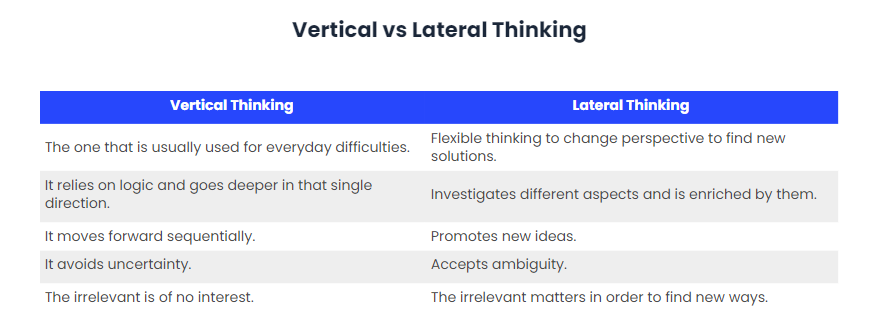Lateral Thinking is the new way of approaching problems

Challenges often arise that seem to have no solution, sometimes looking for a new approach to thinking can be the solution to the problem. Through new frameworks and models of thinking, new methods of reasoning and problem solving can be found. Lateral thinking is one such tool.
Basically, lateral thinking is a creative thinking system that confronts problems to create innovative solutions. Edward de Bono, psychologist and author of lateral thinking, presents this methodology as an alternative to the usual analytical thinking of human beings.
It describes an approach and a set of tools to innovate, generate new ideas and adapt them to the constraints of the real world. It should also be clear that this thinking describes a series of specific techniques:
- Considering alternative solutions: even if the solutions to the problems are obvious, it is interesting to set these solutions aside to deliberately study different alternatives. In such a way that the problem is viewed from all possible angles.
- Random stimulation: The generation of random stimuli can help to find unexpected solutions. Something as simple as walking enhances creativity.
- Subtractive thinking: Generally, when solving problems, human beings tend to add things such as creating new products or a new project. Subtractive thinking is the opposite, it consists of subtracting things, subtracting the parts of the problem.
Why should lateral thinking be used?
Lateral thinking is based on applying logic in an unconventional way, from a logic perspective to the application of a problem to reach a different and creative solution. This thinking is still rational and logical.
Edward de Bono uses the example of King Solomon to explain it. King Solomon, when in doubt as to whether he was the father of a child, advised cutting him in two, although this seems illogical for a father, it is not illogical for a king who wants to make his judgement by measuring the reactions of the person who receives the order. Thus, the logic in lateral thinking consists of replacing some part of the logical flow in classical problem solving with another lateral line of the logical flow, and linking it through creative analogies.
In other words, lateral thinking deals with the value of the movement of new ideas. It also produces solutions in which the problem seems obvious in retrospect, thus confirming the logic inherent in lateral thinking solutions.
Lateral thinking occurs when questions are raised as to why things are the way they are. An example might be why the sewers in all cities are round and not square, and the answer is not because they are easier to transport.
The key elements of lateral thinking and how to use them
This type of lateral thinking is made up of a number of fundamental elements:
- Check assumptions: all conventional ideas and concepts should be checked and reviewed, and this task should be done with a group of people with an open mind to deal with different environments and situations.
- Asking the right questions: Lateral thinking is fuelled by asking the right questions to find the right solutions to the problem.
- Creativity: this thinking is based on always finding another point of view because direct logic is not useful for solving certain problems.
- Logical thinking: although this thinking is not traditional logical thinking, it is important to define a new logic and deduction based on reasoning. This thinking must be orderly, clear and concise so that everyone in the company can understand it.
Therefore, companies that want to make use of this type of thinking should use free association to generate random thoughts in the process of idea creation and problem solving. Also, the concept of reversing a problem or turning an idea on its head can be employed, which in practice could be thinking about how to increase the level of customer complaints, rather than trying to decrease them, in order to obtain a set of new alternatives and actually achieve a minimum number of complaints.
By distorting the facts, lateral thinking can also be carried out, seeking to maximise or minimise events to give a new perspective on the problem. Likewise, trying to summarise the situation in one word using a nominal value also creates a new method of approaching the problem. In addition, factoring allows for decomposition into parts and, by recombining them, creates a new set of alternatives.
Thus, it is important for companies that choose to use this type of thinking to look for techniques to enhance their creativity by using checklists to learn about the different characteristics of lateral thinking. For example, by factoring, the characteristics of the problem can be broken down into several ideas and, in turn, these can be interchanged with other ideas.
By using lateral thinking, the alternatives that emerge can be used to create a new product or service by redefining the problem with a different point of view, always knowing the causes and effects of the problem.

Finally, the use of analogies is used to compare the characteristics of similar aspects. These can be classified into four different types of analogies:
- Personal analogies: used to identify the difficulties of the problem from a single point of view.
- Direct analogies: focus on the characteristics of a problem to create a list of observable things. This list is used to detect similarities and comparisons.
- Symbolic analogies: use the key elements of a product or problem, using graphic description or an image.
- Fantasy analogies: these are used by imagining a more perfect situation and removing judgement from all the ideas generated, so that they can subsequently be associated in a new way. The result is solutions that do not follow a traditional scheme.
Therefore, various types of brainstorming exercises can be carried out to generate this lateral thinking. However, this methodology can also be used to foster relationships in work teams and to encourage them to acquire a new way of working and relating to each other. in general, it can be a good method to establish stimulating and fun relationships that can sometimes change the overall way of thinking in a company, leaving behind its linear methodology.
The Domino’s Pizza Success Story
The Domino’s Pizza company made use of lateral thinking to overcome criticism and complaints about the condition of the pizzas when they were delivered to people’s homes. This was due to potholes in the roads. So Domino’s looked at different creative solutions to benefit from this situation, improving customer service and solving its own adversities.
Domino’s financed different teams with trucks, in which they inscribed on the vehicles “Bad roads shouldn’t happen to good Pizza”. In this way, financed by Domino’s, these teams fixed road areas and potholes only on the streets most frequented by their delivery drivers.
Conclusions
The lateral method enriches each idea, either through the individual’s own differentiated experience of the thinking pattern or through the acquired knowledge of the individual or the group. This type of thinking does not have a unique typology, but is always based on logic and rationality.
Despite being a concept that was born decades ago, recently there has been a special interest in lateral thinking in order to improve the Customer Experience and give a new approach to the marketing areas of companies.
Finally, it is important to specify that vertical thinking and lateral thinking should not be seen as opposing concepts, as the latter complements the former.


